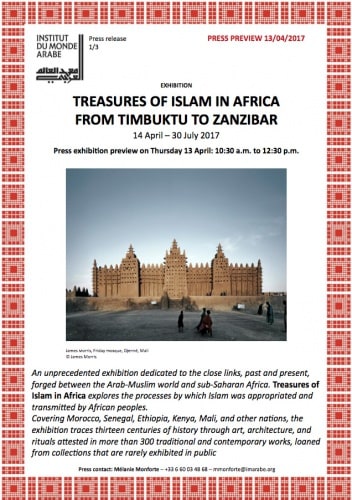An unprecedented exhibition dedicated to the close links, past and present, forged between the Arab-Muslim world and sub-Saharan Africa. Treasures of Islam in Africa explores the processes by which Islam was appropriated and transmi ed by African peoples.
Covering Morocco, Senegal, Ethiopia, Kenya, Mali, and other nations, the exhibition traces thirteen centuries of history through art, architecture, and rituals attested in more than 300 tradi onal and contemporary works, loaned from collec ons that are rarely exhibited in public
TRANSMISSION: FROM COMMERCE TO JIHAD
As of the 8th century, Islam spread throughout sub-Saharan Africa via trading networks. Three dis nct geographical regions developed in this zone in which peoples and goods circulated: ini ally, the Horn of Africa and the Nile valley, followed by the Swahili area, and lastly West Africa. Presented chronologically, each of these regions adopted Islam di erently as they came into contact with Arab traders and subsequently Muslim scholars. Contradic ng the idea of a con nent in which oral transmission is believed to prevail, ‘Treasures of Islam in Africa’ focuses in par cular on the city of Timbuktu, the famous centre for the di usion and preserva on of knowledge that was recently under threat. A dozen manuscripts from Timbuktu’s Mamma Haidara Library will be exhibited for the rst me. Lastly, exploring the history of the jihads carried out in the 19th century, the exhibi on focuses on contemporary African jihad movements.
PRACTICES: ARCHITECTURES, RELIGION, AND MAGIC
The highly diverse Islamic prac ces in sub-Saharan Africa have been integrated into the architectural edi ces that are part of local tradi ons, and which are very di erent from the familiar buildings of the Arab-Muslim world. The places of worship are as varied as the types of building, from madrasas and zawiyas to mausoleums. They are o en built by the Su brotherhoods that organise the religious life within societies.
These varied rituals are very o en borrowed from pre- Islamic tradi ons. Hence, masks from Ghana and the Ivory Coast will also be displayed. As intermediaries between man and gods, these masks were also used in
the Muslim religion. Exhibited for the very rst me will be royal objects from the mid 19th century, loaned from a private collec on and a es ng to the synthesis between Islam and animist rituals. The explora on of these diverse prac ces will be complemented by the study of the dances and songs of the Moroccan Gnaouas and the making of talismans.
APPROPRIATIONS: EVERYDAY AND LOCAL OBJECTS
Religion aside, the Muslim culture is also evident in the art and cra s associated with daily life. Islam expanded through the work of Muslim ar sts and cra smen— painters, smiths, goldsmiths and silversmiths, weavers, and so on—, whose priceless know-how also spread across the con nent. In fact, forms spread more easily and uidly than ideas. Regional speci ci es subsequently emerged. The boubou tradi on was therefore interpreted according to the couturiers and their region: ‘riga’ and ‘agbada’ boubous in Nigeria and ‘ lbi’ and ‘lomasa’ boubous in Mali. Likewise, calligraphy and alphabets have created speci c forms that inspire contemporary ar sts. Ar sts such as Ibrahim Al-Salahi, Abdulaye Konaté, Rachid Koraïchi,and Babacar Diouf, explore their Muslim heritage in the monumental installations set up in ‘Treasures of Islam in Africa’ exhibi on, forming a complement to the tradional works on display.
As part of ‘Treasures of Islam in Africa: From Timbuktu to Zanzibar’, The Arab World Ins tute (IMA) will give the writer Alain Mabanckou carte blanche on ve Sundays (16 and 23 April, and 4, 11, and 18 June 2017). A music and lm season will also be devoted to the theme of Africa from April to June 2017, with, in par cular, concerts by Inna Modja and Manu Dibango. Lastly, in May 2017, two ‘IMA Thursdays’ will be devoted to the exhibiton themes.


